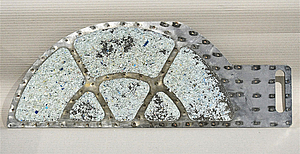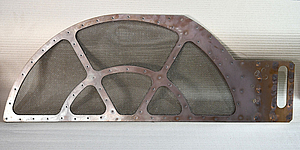"Our packaging customers use our particularly gentle and environmentally friendly vacuum pyrolysis technology to clean these filters," explains Virgilio Perez Guembe, thermal cleaning expert from SCHWING Technologies. Unlike lengthy manual procedures, this fully automated process only takes about eight to ten hours. "Our VACUCLEAN systems clean quickly and in a single operation, which saves not only time but manpower as well," emphasizes Perez Guembe, pointing out that users also benefit from optimized digital networkability of the systems.


The thermal vacuum cleaning system VACUCLEAN. (Photo credit: Schwing Technoogies)
rPET
SCHWING Technologies: Efficiently remove recycled PET from metal filters with vacuum pyrolysis technology
Recycled PET (rPET) is increasingly being used to produce fruit and vegetable trays: Circular packaging is the buzzword here. Metal filters used in the production processes of large manufacturing plants have to be changed daily, partly replaced each shift, and rPET residues must be removed.

Short cleaning times for rPET-contaminated filters
Examples of these applications are approx. 85 x 35 cm (W x H) metal filters, which are used in the manufacturing process of fruit and vegetable trays. The producer, a Spanish packaging manufacturer, works with rPET. The company must clean its filters daily, using vacuum pyrolysis technology and SCHWING’s special expertise in cleaning. Technical factors such as the individual cleaning time, the vacuum atmosphere, the exact temperature curve and the maximum temperature of the entire process were specifically tailored to the filter systems and this user’s rPET. “To accelerate the cleaning process even further, we also made a loading basket for our customers that was specially adapted to the dimensions of the filters," reports SCHWING’s expert.

Environmentally friendly cleaning process in the vacuum pyrolysis system
Cleaning takes place in an electrically heated vacuum cleaning chamber, the temperature of which is measured directly at the filter. Perez Guembe describes the environmentally friendly cleaning process as follows: “So that a large part of the rPET can initially melt and flow out, the system heats up slowly and is gentle on the materials. The actual pyrolysis process that decomposes the rest of the polymer only starts at around 440 degrees Celsius.” Remaining carbon is removed by a subsequent oxidation phase at around 450 degrees Celsius. All of this happens fully automatically and leaves almost no residue. If necessary, the last inorganic residues are removed manually with compressed air.
Digital integration of the VACUCLEAN cleaning system
To digitally optimize the fully automatic cleaning process, the SCHWING development team has expanded the thermal vacuum pyrolysis system by several new components. In addition to a new touch panel with network connection, these digital components also include an internal data connection for data mining and digital system documentation in the SCHWING cloud. Further technical innovations include fully electronic flow measurement for catalyst supply air, a process signal lamp, and a revised fault reporting concept. "All of these measures significantly reduce cleaning times, which is particularly important for our customers in the packaging industry," says Perez Guembe.
The comPETence center provides your organisation with a dynamic, cost effective way to promote your products and services.

magazine
Find our premium articles, interviews, reports and more
in 3 issues in 2025.



